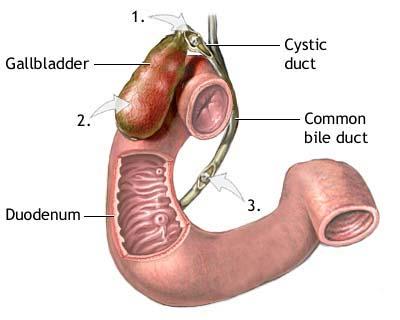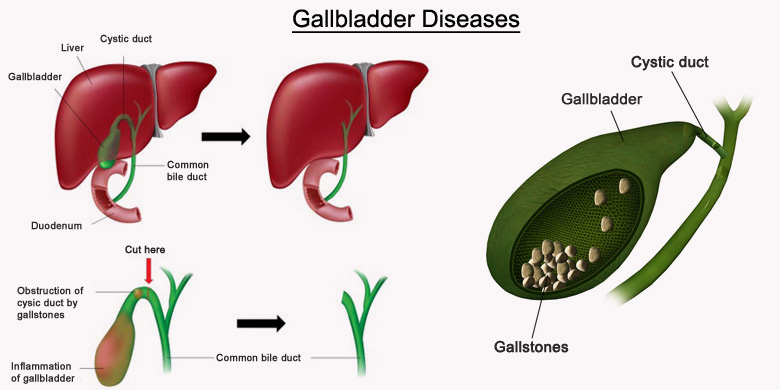GALLBLADDER DISEASE
GALLBLADDER DISEASE
1. Overview of Gallbladder Disease
The term “gallbladder disease” is used for several types of conditions that can affect your gallbladder. The gallbladder is a small pear-shaped sac located underneath your liver. Your gallbladder’s main function is to store the bile produced by your liver and pass it along to the small intestine. Bile helps you digest fats in your small intestine.
The majority of gallbladder diseases are caused by inflammation due to irritation of the gallbladder wall, which is known as cholecystitis. This inflammation is often due to gallstones blocking the ducts leading to the small intestine and causing bile to build up. It may eventually lead to necrosis (tissue destruction) or gangrene. Other diseases of the gallbladder include gallbladder polyps and gallbladder cancer.

2.What Are the Types of Gallbladder Disease?
Gallstones
Gallstones develop when substances in the bile (such as cholesterol, bile salts, and calcium) form hard particles that block the passageway to the gallbladder. Gallstones also tend to form when the gallbladder doesn’t empty completely or often enough. They can be as small as a grain of sand or as large as a golf ball.
Numerous factors contribute to your risk of gallstones. These include:
- Being overweight or obese
- Eating a high-fat or high-cholesterol diet
- Having diabetes
- Being age 60 or older
- Taking medications that contain estrogen
- Having a family history of gallstones

Cholecystitis
Cholecystitis is the most common type of gallbladder disease. It presents itself as either an acute or chronic inflammation of the gallbladder.
Acute Cholecystitis: Acute cholecystitis is generally caused by gallstones, but it may also be the result of tumors or various other illnesses. It may present with pain in the upper right side or upper middle part of the abdomen. The pain tends to occur right after a meal and ranges from sharp pangs to dull aches that can radiate to your right shoulder. Acute cholecystitis can also cause:
- Fever
- Nausea
- Vomiting
- Jaundice
- Different colored stools
Chronic Cholecystitis: After several attacks of acute cholecystitis, the gallbladder will shrink and lose its ability to store and release bile. Abdominal pain, nausea, and vomiting may occur.
Choledocholithiasis
Gallstones may become lodged in the neck of the gallbladder or in the bile ducts. When the gallbladder is plugged in this way, bile can’t exit. This may lead to the gallbladder becoming inflamed or distended. The plugged bile ducts will further prevent bile from traveling from the liver to the intestines. Choledocholithiasis can cause:
- Extreme pain in the middle of your upper abdomen
- Fever
- Chills
- Nausea
- Vomiting
Acalculous Gallbladder Disease
Acalculous gallbladder disease, or biliary dyskinesia, occurs without the presence of gallstones. It can be chronic or acute and may result from the gallbladder muscles or valve not working properly. The symptoms can include abdominal pain on the right side of your body that radiates to your shoulder. Eating foods high in fat often triggers this. Related symptoms may include:
- Nausea
- Vomiting
- Bloating
- Loose stools
Sclerosing Cholangitis
Inflammation, scarring, and damage to the bile ducts is referred to as sclerosing cholangitis. It’s unknown what causes the disease. People with sclerosing cholangitis may have an enlarged liver or spleen along with a decrease in appetite and weight loss.
Gallbladder Cancer
Cancer of the gallbladder is a relatively rare disease. If it’s not treated, however, it can spread from the inner walls of the gallbladder to the outer layers and then to the other organs and ducts. The symptoms of gallbladder cancer may be similar to those of acute cholecystitis.
Gallbladder Polyps
Gallbladder polyps are lesions or growths that occur on the gallbladder. They’re usually benign and have no symptoms.
Gangrene of the Gallbladder
Gangrene develops when the gallbladder stops functioning due to inadequate blood flow. This may occur due to:
- Infections
- Injury
- Diabetes
- Surgery
- Diseases related to blood circulation
The symptoms of gallbladder gangrene can include:
- Pain in the gallbladder region
- Fever
- Nausea or vomiting
- Gas
- Disorientation
- Low blood pressure
Abscess of the Gallbladder
Abscess of the gallbladder results when an area of the body becomes inflamed with pus. Pus is the accumulation of white blood cells, dead tissue, and bacteria. It may present with upper right-sided pain in the abdomen.
3. How Is Gallbladder Disease Diagnosed?
To diagnose gallbladder disease, your doctor will ask you about your medical history and perform an abdominal exam. This will include checking for pain in the abdomen. One or more of the following tests and procedures may be used:
- Detailed Patient History: A list of symptoms being experienced and any personal or family history of gallbladder disease are important. A general health assessment may also be performed to determine if there are any signs of a long-term gallbladder disease.
- Physical Exam: Your doctor may perform a special maneuver during the abdominal exam to look for what is referred to as “Murphy’s sign.” During this maneuver, your doctor will put their hand on your abdomen to feel the gallbladder, and then ask you take a breath while palpating near the gallbladder. If you feel severe pain, it suggests you may have gallbladder disease.
- Chest and Abdominal X-Ray: Symptomatic cholecystitis will sometimes show stones on abdominal X-rays if the stones contain calcium. An X-ray of the chest may show pleurisy or pneumonia. However, your doctor should keep investigating even if your X-ray is normal.
- Ultrasonography: Ultrasonography uses sound waves to produce images of your organs. Ultrasonography is the main method of diagnosis for gallbladder disease and usually reveals the presence of gallstones, thickened walls, or any other problems in your gallbladder.
- Other Investigations: Blood tests are done to check for increased white blood cells and liver function.
4. How Is Gallbladder Disease Treated?
Medical Treatment: The first episode of gallbladder inflammation without gallstones is often treated with antibiotics and pain medications. If you have multiple episodes, your doctor may recommend surgery.
Surgery: Sometimes surgery to remove the gallbladder is your best option. It can be done either by opening your abdomen, or laproscopically, which involves making three holes and inserting a camera. Laparoscopic surgery allows for easier and faster recovery with minimal scarring. Most surgeons prefer to use this method for those who don’t have urgent complications.
5. Potential Long-Term Complications of Gallbladder Disease
The gallbladder may form an abnormal passageway, or fistula, to help process the liver’s bile. This is the most severe problem associated with gallbladder disease. Complications can also include:
- Obstruction of the intestine
- Inflammation
- Perforation (a hole in the gallbladder)
- Bacterial contamination
- Malignant transformation
6. Can Gallbladder Disease Be Prevented?
Your diet may play a role in developing gallstones. According to the National Institute of Diabetes and Digestive and Kidney Diseases (NIDDK), you should eat foods high in fiber and healthy fats to help prevent gallstones. Refined grains (found in sugary cereals and white rice, bread, and pasta) and sugar are associated with a higher risk of gallbladder disease. Whole grains like brown rice and whole wheat bread and fats from fish and olive oil are all recommended.
Source:healthline.com
Liquid Nano Curcumin OIC is available in large pharmacies in Vietnam. Please contact our Customer Service Hotline at 1900636913 or access DISTRIBUTION CHANNELS to receive information of the nearest pharmacy.
The product is not a medicine and cannot replace medicines
The most-read articles
- HEALTHCARE AND THE USE OF NANOTECHNOLOGY IN MEDICAL APPLICATIONS
- HOME REMEDIES FOR A STOMACH ULCER
- GALLBLADDER DISEASE
- TRY TURMERIC FOR QUICK RELIEF FROM A SORE THROAT
- Pycnogenol
- THE BEST THINGS TO KNOW ABOUT THE ALOE VERA PLANT
- RESULTS OF SCIENTIFIC RESEARCH ON LIQUID NANO CURCUMIN OIC
- NANOTECHNOLOGY IN COSMETICS
- OESOPHAGEAL CANCER
- Health Benefits of Mint Leaves
Send your question



